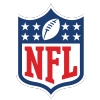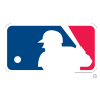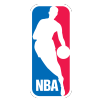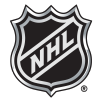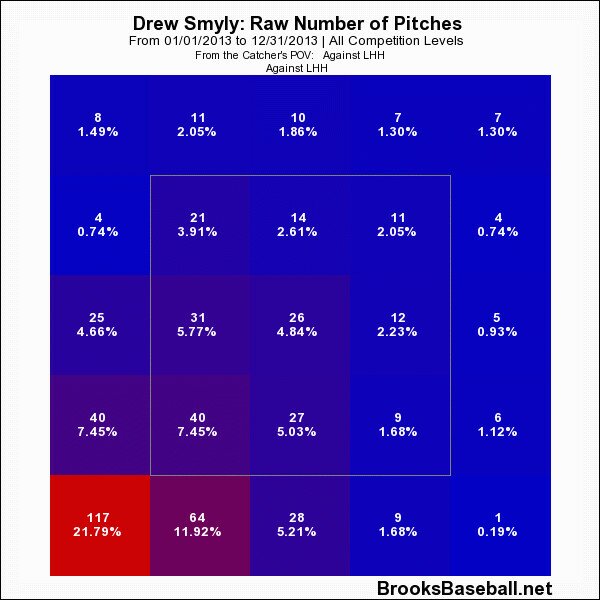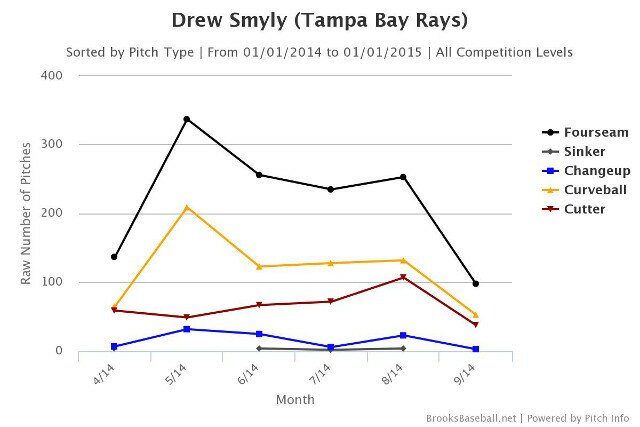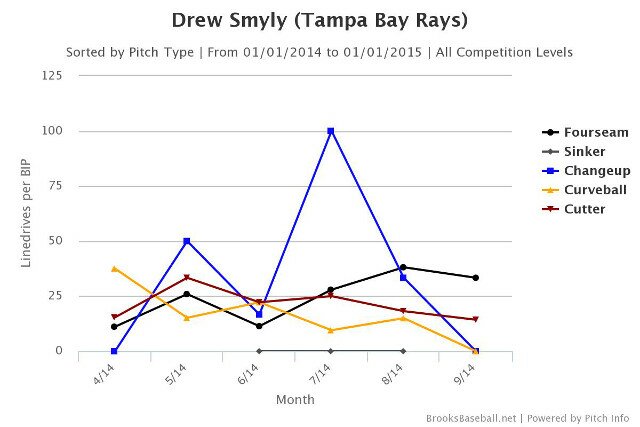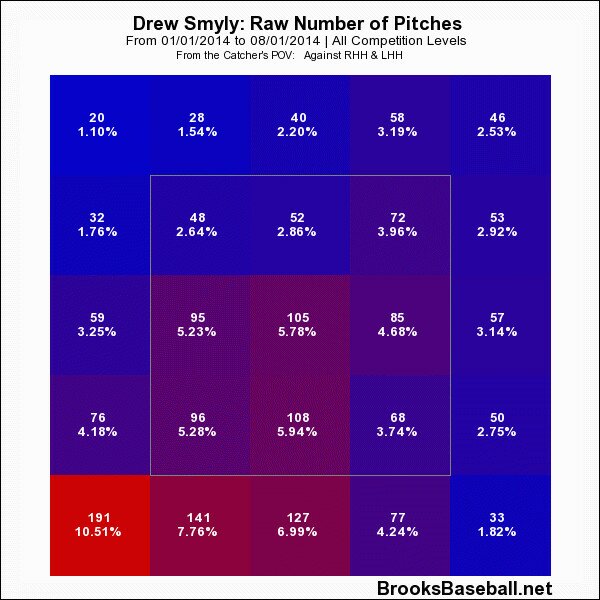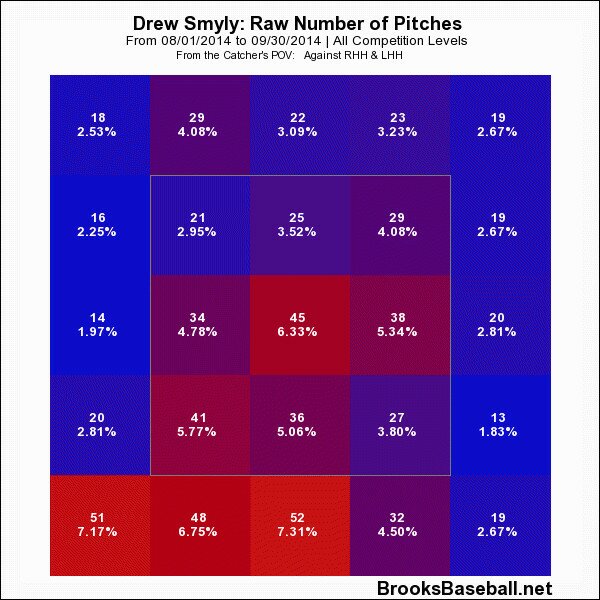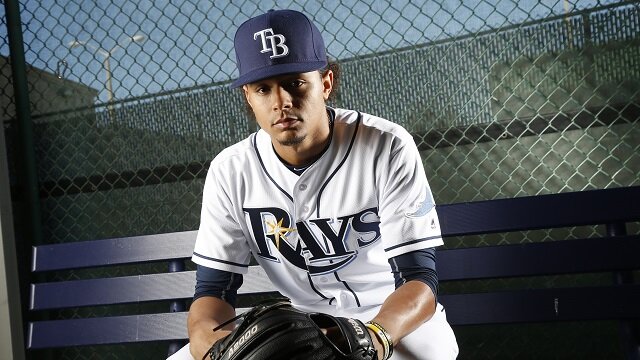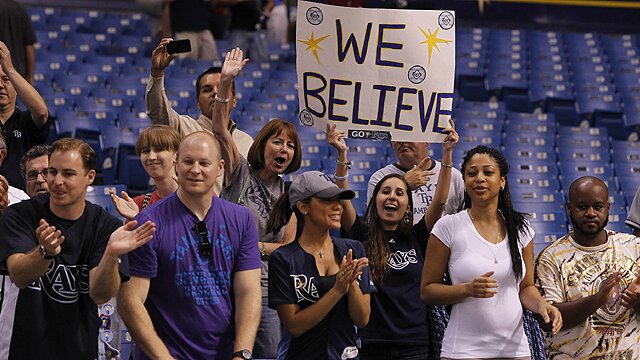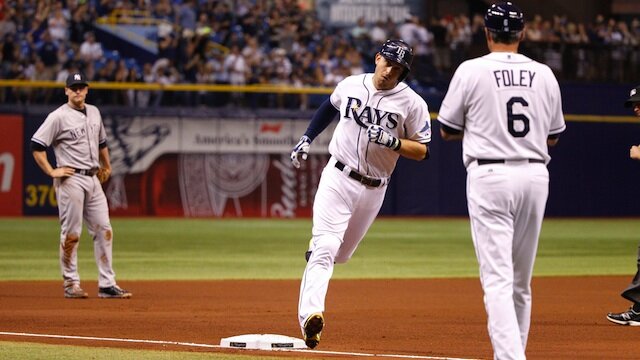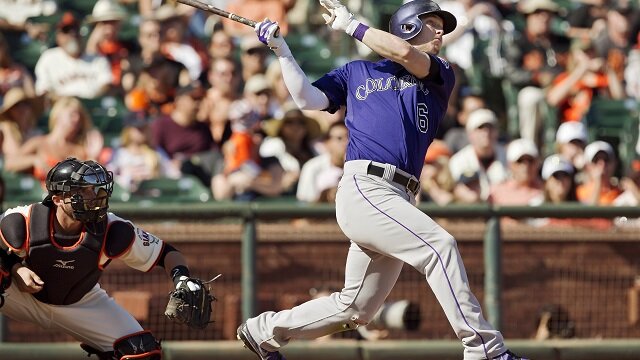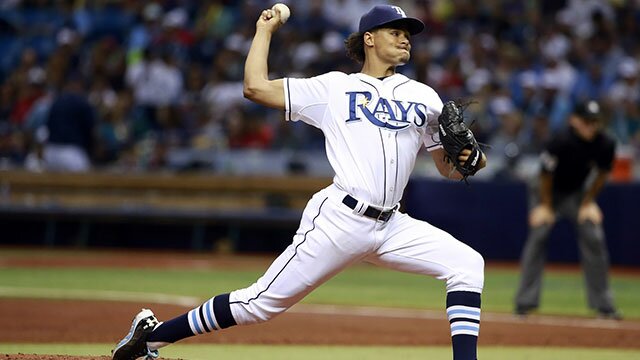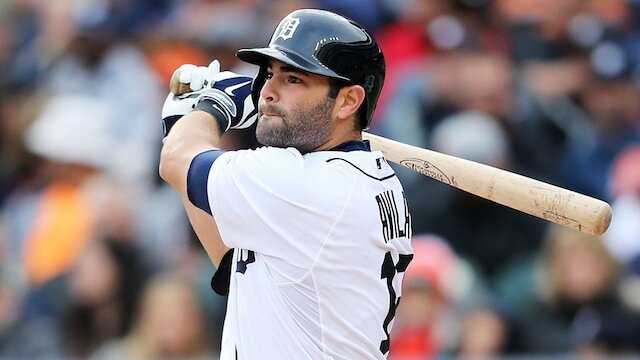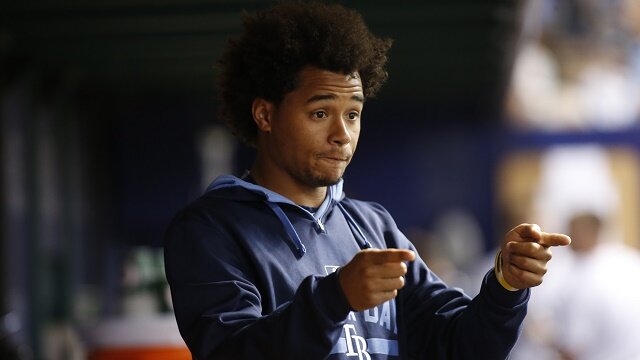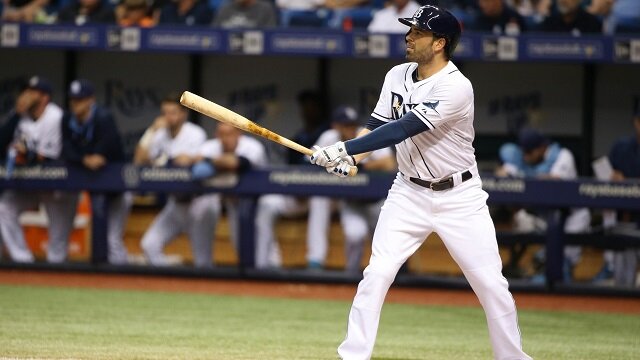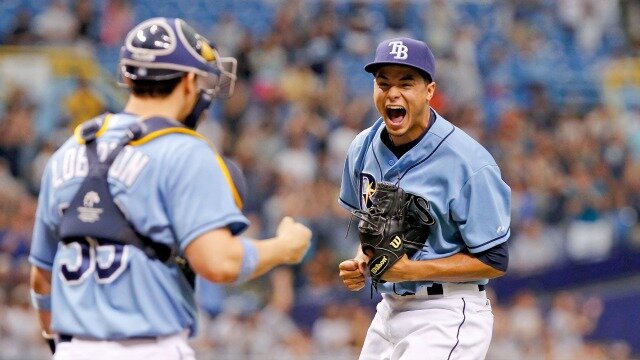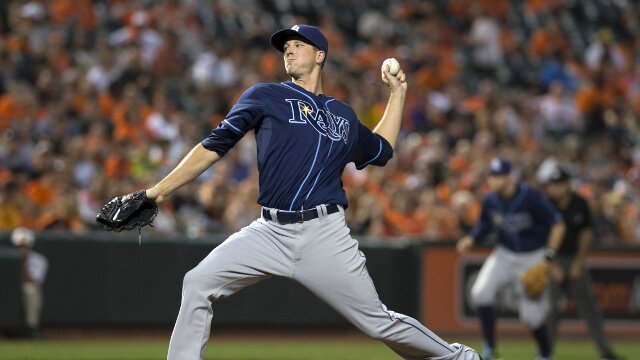
After 2012 AL Cy Young award winner David Price was traded to the Detroit Tigers in a three-team deal last summer, many wondered whether or not the Tampa Bay Rays received enough in return. Make no mistake, however; the Rays received a very nice package of talent that should undoubtedly help them as they look towards the future.
For starters, Nick Franklin has shown great promise in the minor leagues, and the 19-year-old Willy Adames continues to draw praise as a top prospect. But the immediate return, of course, is 25-year-old southpaw Drew Smyly.
Smyly came to the Rays having already established himself as a very capable MLB pitcher. A versatile arm, Smyly excelled while pitching exclusively out of Detroit’s bullpen in 2013, posting a 2.37 ERA and a 9.59 K/9 while limiting lefties to a .212 wOBA. Smyly liked to work the bottom of the zone in 2013, especially against left-handers, which can be seen in the chart below.
The trade of Doug Fister after the 2013 season, however, allowed Smyly to slide back into the Tigers’ starting rotation, which is where he spent the majority of his rookie campaign back in 2012.
Heading into 2014, many had high hopes for Smyly, thinking he could be the team’s best left-handed starter in years. While he didn’t exactly disappoint, he wasn’t necessarily as lights-out as some believed he would be either. At the time of the trade, Smyly had gone 6-9 with a 3.93 ERA, 4.08 FIP, 3.93 xFIP and a 1.35 WHIP in 21 games including 18 starts.
After making the move to Tampa Bay, however, he seemed to really take off. In seven starts with the Rays, Smyly went 3-1 with a 1.70 ERA and a 0.76 WHIP. The Rays shut him down after he made his final start on Sept. 6, limiting his season to 153.0 innings. Overall, Smyly finished the year going a combined 9-10 with a 3.24 ERA, 3.77 FIP and a 1.16 WHIP in a 2.3 fWAR campaign. He also had 133 strikeouts in 153 innings pitched, which was good for a solid 7.82 K/9.
While Smyly was still very impressive during his time with the Rays, it is worth noting that his FIP, xFIP and SIERA were each higher than his ERA, checking in at 3.07, 3.40 and 3.27 respectively. An extremely low .184 BABIP may further indicate that luck was on his side as well. The fact that he had an 88.8 percent LOB percentage didn’t exactly hurt either.
Perhaps he may have further benefited from pitching in front of a Rays’ defense that posted a team UZR/150 of 0.7 with a 4.5 Def rating, compared to a Tigers team that had a -6.9 UZR/150 and a -42.2 Def rating. That said, while there may have indeed been a certain amount of luck involved, it is also very possible that he may have in fact turned a corner.
Although it was a small sample size, it is interesting to note that Smyly’s K/9 saw an increase, going from 7.60 with the Tigers to 8.31 with the Rays, raising it to 7.82 for the season. His BB/9 also improved, dropping from 2.65 with the Tigers to 2.08 with the Rays, suggesting that he had better command of his stuff.
When it comes to Smyly’s repertoire, he certainly has an intriguing assortment of pitches. While he was able to run his fastball up to a top speed of 95.5 mph while pitching in relief in 2013, he is not particularly overpowering out of the rotation, with his fastball averaging out at 90-91 mph last season. Nevertheless, he does feature the type of legitimate swing-and-miss stuff that could make him an obvious breakout candidate heading into this upcoming season.
While there is some confusion regarding Smyly’s arsenal, it is agreed that he for sure throws a four-seam fastball, a cutter and a seldom used changeup. Fangraphs’ Pitchf/x data also has him throwing a two-seam fastball, whereas Brooks Baseball says he has a sinker which he uses sparingly.
The biggest controversy, however, seems to surround his bread-and-butter breaking pitch, which has been classified as both a curveball and a slider. Some have also described the pitch as a “slurve,” meaning that it is a combination of a slider and a curveball. Brooks Baseball has Smyly throwing a curveball, and so does Fangraphs’ Pitch Type data, but under Fangraphs’ Pitchf/x data, the pitch is classified as a slider.
Regardless of what it is called, however, one thing is for certain: it has been an excellent pitch for him.
According to Fangraphs’ Pitch Values Data, the breaking ball was given a rating of 8.2 runs above average, making it his best pitch. According to PITCHf/x, Smyly had a swinging strike rate of 15.3 percent and a contact rate of 68.2 percent with the slider/curveball. Opponents were only able to muster a .186 batting average against it.
Smyly’s cutter was also a significant weapon for him, yielding a 10.7 percent swinging strike percentage with opponents mustering a mere .178 BA against the pitch according to Fangraphs.
As seen in the chart below, Smyly’s usage of the cutter made a noticeable jump after joining the Rays in August.
Plus, not only did Smyly begin throwing more cutters in August, but as seen in the next chart, he had fewer line drives per BIP on the pitch.
According to Brooks Baseball, Smyly’s cutter accounted for 28.84 percent of his pitches when he was going strong as a reliever in 2013, but that number fell to just 15.51 percent in 2014, even once he began using it more often once again with the Rays.
Another part of Smyly’s game that has been discussed in baseball circles after making the move to Tampa Bay is the fact that he began to throw more pitches up in the zone. When Smyly was pitching out of the Tigers’ rotation in the first four months of last season, he largely stuck to working the bottom half of the zone, similar to when he was pitching out of the bullpen in 2013. This can be seen below.
In his seven starts with the Rays, however, while he continued to work the bottom of the zone, he began throwing a greater percentage of elevated pitches, changing the eye-level of hitters.
While Smyly may have figured something out here, there are still a few parts of his game which appear to be works in progress. Take his changeup, for instance.
Last season, opposing hitters crushed Smyly’s changeup to the tune of a .433 BA, .571 wOBA and a 289 wRC+, so it would be easy to understand if he does not have as much confidence in that pitch as he does in some of his others. Seeing as how he already has an effective fastball, cutter and slider/curveball, however, he could truly be a force to be reckoned with if he can master the changeup.
Smyly’s changeup ties directly into another component of his game that he will need to continue working on: his performance against right-handed hitters. He uses his changeup almost exclusively against righties, and based on the numbers, he still needs to figure out how to retire righties more consistently and efficiently.
Much like his first two seasons, he was excellent against lefties last year, limiting them to a combined .170/.201/.285 triple-slash with a .216 wOBA during his time with the Tigers and Rays. Righties, on the other hand, hit .262/.322/.441 with 14 home runs and a .334 wOBA against Smyly. Over the course of his career thus far, righties are hitting .255/.317/.433 with a .327 wOBA, whereas lefties have managed a mere .191/.233/.303 with a .238 wOBA.
Given the fact that Smyly is not necessarily a power pitcher, it may also be beneficial for him to begin inducing a few more ground balls going forward as well. While Smyly had a 43.4 percent ground-ball rate while pitching out of the bullpen in 2013, that number fell to 36.6 percent while pitching mainly out of the rotation last season.
With the type of stuff he has, he should easily be able to learn how to coax more ground balls as he matures as a pitcher. Perhaps this can be accomplished by continuing to throw more cutters.
Heading into 2015, it appears that Smyly and Jake Odorizzi will round out the back end of the Rays’ bullpen, slotting behind Alex Cobb, Chris Archer and Matt Moore once he is healthy. Much like when he was with the Tigers, there will not be any pressure on Smyly to be the team’s ace, so don’t be surprised to see him grow comfortably into being a well above-average big league starter as he embarks upon his age-26 season.
If Smyly can continue developing his changeup, figure out a way to get righties out, induce a few more ground balls and have a good defense behind him, his future could be very, very bright.
All statistical information courtesy of Baseball Reference, Brooks Baseball and Fangraphs.
Brad Faber is a Senior Writer and Sabermetrics Columnist for www.RantSports.com. Follow him on Twitter @Brad_Faber, “Like” him on Facebook or add him to your network on LinkedIn or Google.


